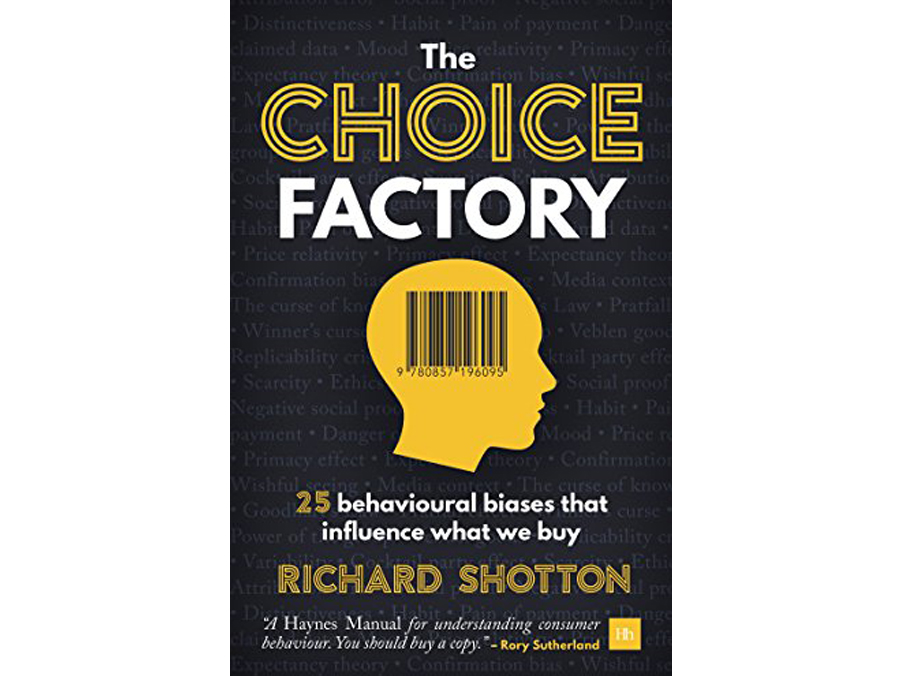Reviewed by Jenifer M. Hartt, Qualitative Research Consultant, Hartt and Mind Market Research, West Hartford, CT, Jenifer@HarttAndMind.com
For a fast, fun read, The Choice Factory by British marketer Richard Shotton illustrates
how twenty-five common behavioral science biases affect consumer decision-making. The book serves as a ready reference manual for marketers and market researchers.
A talented brand strategist, Shotton interweaves real project-related research with peer-reviewed academic studies to illustrate how each of the twenty-five biases work and—this is where he gets really good—how marketers can apply those biases in their work. Each chapter covers a specific behavioral bias, which makes it easy to skip to those chapters you think are most relevant. You’ll learn how a high price can boost demand,
how to take advantage of wishful seeing (where what consumers see is sometimes what they want to see), and how biases affect segments in different, often opposite ways.
Shotton is quick to point out that there isn’t one grand theory that underpins behavioral science. The beauty of having related but distinct biases is that there’s bound to be a behavioral bias that marketers and market researchers can leverage. Rereading The Choice Factory with a political research project in mind has me rethinking my methodology design. If you read it while trying to solve a market research issue, you’ll make unexpected connections that can only improve your deliverables.
Reading this book can be like having a conversation with Shotton; you might find yourself saying, “I wish you’d tested…” only to turn the page and say, “oh, you did think of that.” You may find yourself disagreeing with inferences he draws from the research findings—I did at times—but that’s a function of how engaging his examples are, in that they get you (and keep you) thinking.
Biases like other influential factors such as personality, attitudes, values, education, and household income are not as powerful determinants as context; Shotton makes this point by starting with The Fundamental Attribution Error that explains why brands need to target contexts as much as audiences. He asks who you think would be more likely to help a man slumped in a doorway—a caring person in a rush or a not-so-caring person with plenty of time? Perhaps, you would make the same choice as eighty-one percent of those in his thought experiment and predict the caring person…and you would be wrong.
In a classic 1973 experiment with forty trainee Catholic priests, the trainees were segmented into those who chose the priesthood to help others and those who did so to ensure their own salvation. Sent to record a short five-minute talk, a third were told they were expected a few minutes ago and to hurry, a third that their recording assistant was ready for them and to head on over (an intermediate hurry condition) and, a third were told that the assistant wouldn’t be ready for a few minutes but that if they had to wait, it shouldn’t be long.
As the trainees separately headed toward their destination building, they passed a man pretending to be in distress, who slumped in a doorway and moaned as each trainee passed. Who would stop to help? Personality had only a minor effect. Overall, forty percent stopped but sixty-three percent were those in the “no hurry” condition.
One of my favorite chapters is on The Pratfall Effect, where Shotton talks about how flaws can make a brand more appealing. For example, Doyle Dane Bernbach’s ad campaign helped Avis turn a profit after a decade of red ink with “When you’re only number two you try harder.” The Belgian pilsner Stella Artois transformed its popularity in the UK with “Reassuringly Expensive.”
Many of Shotton’s experiments to see how these biases might shift brand appeal were relatively inexpensive and fast. Prepare to be inspired, and prepare to be entertained as you learn. It’s easy to see why this book won BBH Labs’ 2018 World Cup of Advertising Books and why Shotton was featured in the Fall 2019 QRCA VIEWS Luminaries column.


1 Trackback / Pingback